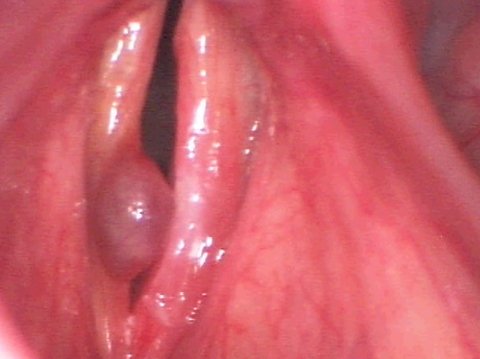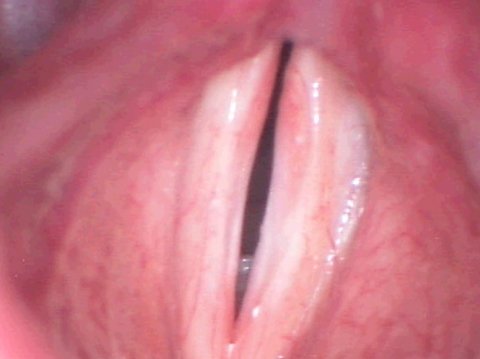When is voice surgery for vocal cord polyps indicated?
Indications for vocal cord polyp surgery:
- Hoarseness, rough voice
- Rapid vocal fatigue
- Impairment of breathing
Polyps on vocal cords usually constitute unilateral tissue lesions of the vocal folds of varying size and shape. The dimensions of vocal cord polyps can vary considerably. In smaller manifestations, the changes in vocal quality are usually only minimal, whereas larger forms can be associated with significant hoarseness extending to aphonia.
The indication for a phonosurgical intervention is usually rendered based on the subjective vocal symptoms the patient presents with. The hallmark symptom is a disturbing hoarseness caused by the limited ability of the vocal folds to vibrate.
Since the degree of hoarseness usually increases with the size of the vocal cord polyp, the visit to a voice surgeon is usually dictated by the individual's subjective perception of the impairment or due to profession-related limitations.
In the case of very large vocal cord polyps, it is also possible that the patient's breathing is impaired. In such cases, the impairment of ventilation — added onto the symptom of hoarseness — represents an urgent indication for surgery of vocal cord polyps.
There are some instances where the surface of vocal cord polyps exhibits a whitish cornified layer that sometimes resembles the aspect of a condition called leukoplakia. Such lesions should be surgically removed for reasons of safety because the clinician’s visual image is often not sufficient for him to differentiate a benign lesion from a malignant process. Likewise, in such cases, an early surgical intervention is indicated.
Vocal cord polyp before surgery

Vocal cord polyp after surgery


How is surgery for vocal cord polyp performed?
Since vocal cord polyps are frequently of the "hemorrhagic polyp” type which is supplied with blood by capillaries, the phonosurgical procedure starts by first cauterizing these supplying blood vessels with a microprobe. If this is not done, significant bleeding could occur during the course of surgery.
The surgical method preferred by Dr. Wohlt involves a plastic reconstructive technique applied to the vocal folds: Here, the diseased vocal cord is surgically managed in a way that achieves unimpaired, free vibratory behavior of the vocal fold mucosa after surgery. This method can produce a resonant postoperative voice.
The first step in this procedure is to open the vocal fold body lateral to the vocal cord polyp and dissect the tissue portions from out of the polyp sac using microinstruments. In the event of intraoperative bleeding, it is necessary to achieve hemostasis by microcautery. Usually, this requires very careful and delicate dissection of the marginal tissue at the vocal fold edge.
The conventional thinking of the past was that a vocal fold polyp could be separated off with a single snip of the micro-scissors and thereby give a successful conclusion to the vocal cord polyp surgery. Quite to the contrary, this is no longer tenable from a modern phonosurgical perspective.
Rather, the dissection is performed with fine, filigree precision to reinstate a smooth vocal fold surface that is capable of vibration.
Larger vocal fold polyps are moreover frequently found to have a pedicled "foot” that is firmly anchored in the subepithelial tissues. It is likewise imperative to dissect out these deep-lying tissues. Otherwise, the residual polyp left in situ might re-develop into a new vocal cord polyp. Therefore, it is sometimes necessary to surgically advance deeper into the vocal fold body.
Excess tissue portions from the tissue sac of the vocal cord polyp are carefully cut off with the micro-scissors. The remaining mucous membrane can be carefully folded over the mucosal defect. After pressure adaptation, the cover layer will usually adhere to the vocal cord body without any problems. Sometimes, the surgeon may rely on techniques from plastic surgery (wedge excision, Z-plasty etc.).
The use of tissue glues, in whatever form, is advised against because they can lead to adhesions and consequently to vocal fold scaring. Normally, the endogenous fibrin produced by the body, supported by compression, is entirely sufficient to achieve flap coverage of the tissue defect.
Vocal cord polyp before surgery
Vocal cord polyp after surgery

What happens during the postoperative phase after surgery for vocal cord polyps?
- Approximately 10-days’ voice rest
- Abstinence from alcohol and smoking
- Voice therapy for between 4 and 6 weeks
After vocal cord polyp surgery, approximately ten days of voice rest should be maintained. During this period, the wound is allowed to heal while reepithelialization of the tissue defect takes place.
The voice rest prescribed during this period is imperative! Whispering should definitely be avoided. Likewise, during the wound healing phase, complete abstinence from smoking is mandated. Given the risk of bleeding associated with alcoholic beverages, drinking alcohol should be abstained from as well.
After conclusion of the vocal rest phase, voice therapy can be initiated. This aftercare makes utmost sense in patients whose vocal fold polyps have developed over a prolonged period. The reason for this is that vocal pressure patterns have become habituated over time and can lead to recurrence of the patient’s voice disorders.
The duration of voice therapy depends on the isolated response of the patient to the individual exercises. In general, postoperative voice therapy is recommended to last around 4-6 weeks.




